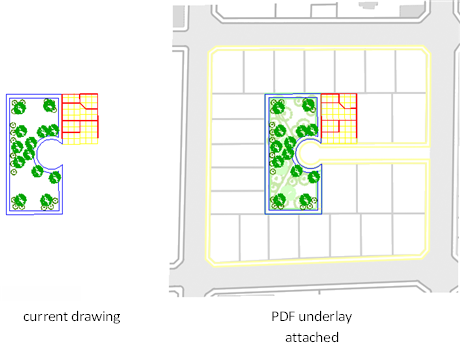You can underlay and snap to 2D geometry stored in DWF, DWFx, DGN, and PDF files.
Underlays are similar to attached raster images in that they provide visual content but also support object snapping and clipping. Unlike external references, underlays cannot be bound to the drawing.

You can underlay the following file types:
- DWF - A DWF (Design Web Format) file is a highly compressed file format that is created from a DWG file.
- DWFx - DWFx, the future of DWF, is based on the XML Paper Specification (XPS) format from Microsoft.
- PDF - Adobe System’s document exchange format.
- DGN - Bentley System’s Microstation format. DGN support is limited to V7/V8 DGN files and 2D objects. The 2D objects are imported or attached with full (X, Y, Z) coordinate information, as was present in the original file. If the file contains 3D solids, surfaces, or other 3D objects, a warning is displayed. This content is not supported in this file.
Use the Ribbon Contextual Tab to Work with Underlays
If you select an underlay when the ribbon is active, the DWF Underlay Ribbon Contextual tab, the PDF Underlay Ribbon Contextual tab, or the DGN Underlay Ribbon Contextual tab displays depending on the type of underlay selected. The contextual tab contains options for adjusting, clipping and displaying underlays. The ribbon contextual tab is dismissed automatically after the underlay is deselected.